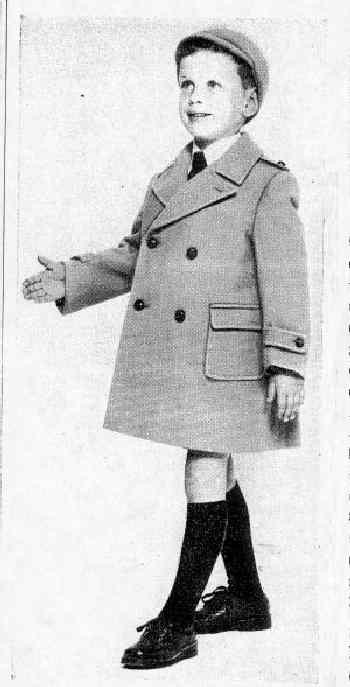
Classic Boys' Cammelhair Overcoats

Figure 1.--This American boy models a classic cammels hair winter coat that was worn with a younger boy's Eton suit. Note the matching cap. The 1959 advertisment with this coat read, "Strolling through the park is a delight in his camel color wool coat, which is an exacy copy of a British officer's greatcoat to the shoulder tabs and patch pockets." It was made in sizes 3 to 6X.
|
American boys wore their Eton suits during the winter with various types of coats. One of the classic winter outfits was a tan cammel hair coat, often with military styling. One coat had epeulets and patch pockets. The coats were made in both single and double breasted styling--but the double breasted styling seems the most common. This contrasts with the suit jackets for younger boys which were almost always single breasted. The coat, unlike the Eton jacket, has lapels with a "V" opening showing the boy's collar and tie. The coats were always made in the natural tan or fawn color of the camelhair. The peaked cap might match the boy's tan coat rather than the material of his Eton suit. The coats were than reefer jackets, but did extend below the length of the boy's short pants. As these coats were winter wear, they were normally worn with kneesocks.
Chronology
These coats seem to have been the most common from the 1930s to the 60s.
Types
American boys wore their Eton suits during the winter with various types of coats. One of the classic winter outfit was a tan cammel hair coat with military styling. These coats were made in both single double breasted styles. The double breasted styles appear to have been the most common, even though they were commonly worn with single breasted suits.
Styling Details
The coat, unlike the Eton jacket, has lapels with a "V" opening showing the boy's collar and tie. These cammelhair coats were commonly made with military styling details. Epaulets and patch pockets were the most common features. The coats were not long, but did extend below the length of the boy's shorts, generally to knee length.
Other Garments
The peaked cap might match the boy's tan coat rather than the material of his Eton suit. As these coats were winter wear, they were normally worn with kneesocks. Unlike the caps, however, the kneesocks were picked to match the boy's suit, usually black or navy, and not the cammel hair coat.
Colors
The coats were always made in the natural tan or fawn color of the camelhair.
Material
Overcoats for men were made in camelhair. Some very expensive boys' coats were also made in cammelhair. More commonly, boys' coats, even expensive boys' clothes, were made in "camel" color wool.
Social Conventions
This conservative style was particularly popular for boys from affluent families. Most American boys wore winter jackets and coats with a variety of trendy styles. This suit has an upper-class or at least affluent look to it.
Christopher Wagner

Navigate the Boys' Historical Clothing Web Site:
[Return to the Main classic overcoat page]
[Return to the Main overcoat page]
[Return to the Main camelhair page]
[Introduction]
[Activities]
[Biographies]
[Bibliographies]
[Chronology]
[Clothing styles]
[Contributions]
[Countries]
[Essays]
[Boys' Clothing Home]
Created: March 14, 20001
Last updated: June 16, 2001



